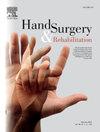慢性月骨周围脱位的手术效果:系统回顾。
IF 1
4区 医学
Q4 ORTHOPEDICS
引用次数: 0
摘要
月骨周围脱位和月骨周围骨折脱位的特点是手腕受到大范围的高能创伤。慢性月骨周围损伤定义为治疗延迟至少6周。本系统综述旨在比较慢性月骨周围损伤的各种手术技术和结果。使用PubMed、Embase、Scopus和Web of Science,根据系统评价的首选报告项目和meta分析声明指南,对慢性月骨周围脱位和月骨周围骨折脱位的文献进行系统综述。共纳入326篇文献,最终纳入13篇文献158例患者。我们证明了59%的月骨周围骨折脱位,30%的月骨周围脱位和11%的月骨脱位。损伤机制主要为高能跌落(31%)和机动车事故(50%)。50%的患者在初次就诊时有正中神经症状/感觉异常。手术技术包括近端肩胛骨切除术(34%)、切开复位内固定(49%)、舟状骨切除术合并四角融合术(7%)、腕关节融合术(2%)、部分月骨/舟状骨切除术(1%)、全月骨切除术(5%)和孤立腕管松解术(1%)。平均随访时间为5年。在最后的随访中,有28%的放射性骨关节炎发生率,只有3例患者进行了全腕部关节融合术。无论采用何种手术技术,患者的疼痛水平均有所改善,再手术率低,但术后手腕活动范围和握力下降。本文章由计算机程序翻译,如有差异,请以英文原文为准。
Surgical outcomes in chronic perilunate dislocations: A systematic review
Perilunate dislocations and perilunate fracture-dislocations are marked by a wide range of high energy trauma to the wrist. Chronic perilunate injuries are defined by a treatment delay of at least 6 weeks. This systematic review aims to compare the various operative techniques and outcomes for chronic perilunate injuries. A systematic review of literature on chronic perilunate dislocations and perilunate fracture-dislocations were performed according to Preferred Reporting Items for Systematic Reviews and Meta-analysis statement guidelines using PubMed, Embase, Scopus, and Web of Science. A total of 326 articles were included, of which ultimately comprised of 13 articles with 158 patients. We demonstrate a rate of 59% perilunate fracture-dislocations, 30% perilunate dislocations, and 11% lunate dislocations. Mechanisms of injury were mostly high energy falls (31%) and motor vehicle accidents (50%). Fifty percent of patients had median nerve symptoms/paresthesias at time of initial presentation. Surgical technique included proximal row carpectomy (34%), open reduction internal fixation (49%), scaphoid excision with four corner fusion (7%), wrist arthrodesis (2%), partial lunate/scaphoid excision (1%), total lunate excision (5%), and isolated carpal tunnel release (1%). Average follow-up of time was 5 years. There was a 28% incidence of radiologic osteoarthritis at final follow-up with only 3 patients undergoing conversion to total wrist arthrodesis. Regardless of surgical technique, patients experienced improved levels of pain with a low reoperation rate, but decreased wrist range of motion and grip strength post-operatively.
求助全文
通过发布文献求助,成功后即可免费获取论文全文。
去求助
来源期刊

Hand Surgery & Rehabilitation
Medicine-Surgery
CiteScore
1.70
自引率
27.30%
发文量
0
审稿时长
49 days
期刊介绍:
As the official publication of the French, Belgian and Swiss Societies for Surgery of the Hand, as well as of the French Society of Rehabilitation of the Hand & Upper Limb, ''Hand Surgery and Rehabilitation'' - formerly named "Chirurgie de la Main" - publishes original articles, literature reviews, technical notes, and clinical cases. It is indexed in the main international databases (including Medline). Initially a platform for French-speaking hand surgeons, the journal will now publish its articles in English to disseminate its author''s scientific findings more widely. The journal also includes a biannual supplement in French, the monograph of the French Society for Surgery of the Hand, where comprehensive reviews in the fields of hand, peripheral nerve and upper limb surgery are presented.
Organe officiel de la Société française de chirurgie de la main, de la Société française de Rééducation de la main (SFRM-GEMMSOR), de la Société suisse de chirurgie de la main et du Belgian Hand Group, indexée dans les grandes bases de données internationales (Medline, Embase, Pascal, Scopus), Hand Surgery and Rehabilitation - anciennement titrée Chirurgie de la main - publie des articles originaux, des revues de la littérature, des notes techniques, des cas clinique. Initialement plateforme d''expression francophone de la spécialité, la revue s''oriente désormais vers l''anglais pour devenir une référence scientifique et de formation de la spécialité en France et en Europe. Avec 6 publications en anglais par an, la revue comprend également un supplément biannuel, la monographie du GEM, où sont présentées en français, des mises au point complètes dans les domaines de la chirurgie de la main, des nerfs périphériques et du membre supérieur.
 求助内容:
求助内容: 应助结果提醒方式:
应助结果提醒方式:


